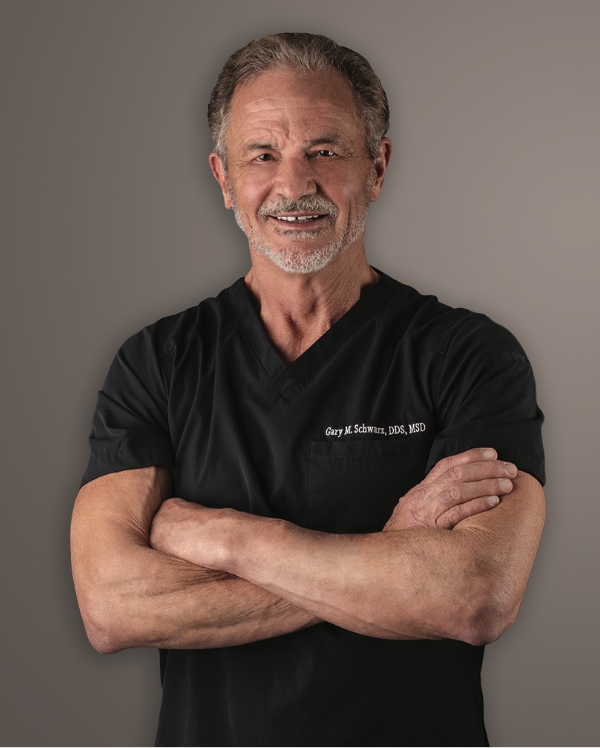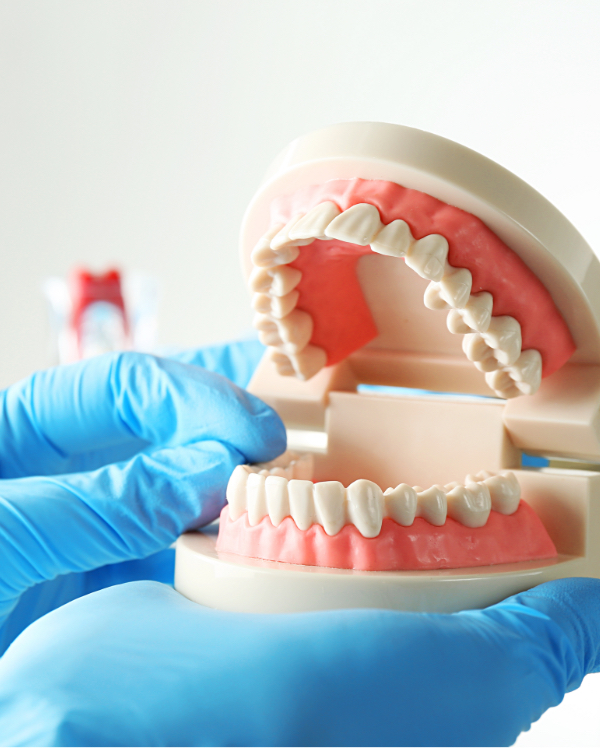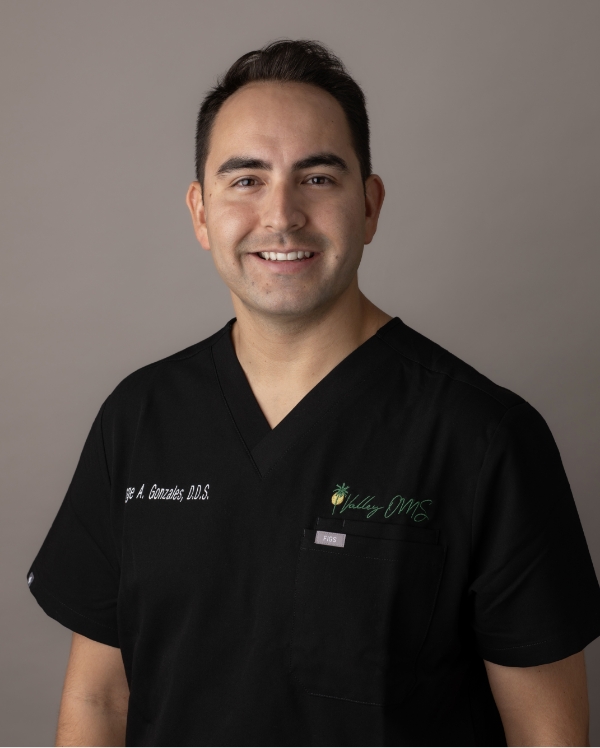
At Valley OMS, we see patients suffering from a number of different pathologies involving their mouth, face, or neck. Often, we see men and women complaining about chronic pain in their jaw, their temple, on the sides of the neck and shoulders. In other instances, they are worried about a telltale “clicking” sound any time they move the jaw or even a locking jaw that only opens halfway. These are all potential symptoms of TMJ disorder, a condition that is very common, very painful, and highly treatable.
Our oral surgeons have provided relief to countless TMJ disorder patients throughout South Texas with a range of different treatment options. We welcome you to learn more about Valley OMS and our services.
What is TMJ Disorder?
The disorder gets its name from the temporomandibular joint, or TMJ, which is sort of like a sliding hinge that connects the lower jawbone to the rest of the skull. There is a joint on each side of the jaw. TMJ disorder is an umbrella term that is associated with pain in this joint and/or in the surrounding muscles of the head and neck that are involved with the movement of the lower jaw.
There are various factors that may contribute to TMJ disorder. Some patients are genetically predisposed to TMJ pain, while others may develop TMJ disorder as the result of clenching habits or tooth grinding, malocclusion (teeth are not hitting right), severe stress, rheumatoid arthritis, and jaw injury.
Do I Have TMJ Disorder?
There are some common symptoms used to diagnose TMJ disorder. You may have the disorder if you struggle with any of the following concerns:
- You regularly wake up with sore, stiff jaw muscles.
- You are aware of unhealthy behaviors such as tooth grinding or jaw clenching.
- You regularly suffer from intense headaches or neck and/or shoulder tightness and soreness.
- When you open your mouth, your jaw tends to click, pop, grate or catch.
- You experience pain when you try to open your mouth, eat, or yawn.
- Your jaw is locked open or limited in opening.
If you believe you have TMJ disorder, based on any of these symptoms, we recommend pursuing a formal diagnosis, which can be the critical first step toward preventing progression of the dysfunction.
Am I a Good Candidate for TMJ Treatment?
There are a number of treatments available for those suffering from TMJ disorder. At Valley OMS, our doctors will first want to schedule a consultation, confirm the diagnosis, and determine the type of treatment best suited for your case.
For those who need surgical intervention to relieve TMJ symptoms, it will also be important for us to ensure you are in good medical health overall and do not have any underlying conditions that would prevent you from proper healing.
What are the Treatment Options for TMJ Disorder?
At Valley OMS, we take pride in having a full TMJ toolbox at our disposal. Based on the patient’s specific needs, there are a multitude of treatments we might draw from. A few of the most common examples include:
Medications
Different medications, including anti-inflammatory drugs, can sometimes greatly improve TMJ symptoms.
Botox
Approximately 10% of our TMJ patients can benefit greatly from BOTOX® injections when muscles show abnormal enlargement, much like the muscles of bodybuilders. For the TMJ patients who need Botox, it is most often needed when patients have enlarged cheek muscles (masseter muscles). These are muscles you can feel just in front of your ears when you clench your teeth. The enlargement of these cheek muscles can even affect the balance of your facial aesthetics, causing a “square jaw” appearance.
TMJ Splint
By far the most common tool we will use to give you improvement in your symptoms. This is like a mouth guard, but is far more sophisticated than a simple inexpensive mouth guard you might purchase from your Dentist or drug store, but rarely will they help TMJ. More often, they will make it worse.
The TMJ splint design used by VOMS doctors is the one recommended by the Prestigious LD Pankey and Dawson Academics, of which Dr. Schwarz is a graduate. Almost all of our TMJ patients have imbalances in their bite. This splint design eliminates these when it is worn at night only. Think of it as snapping on a perfect bite, like a custom orthopedic for shoes of people having back or hip pain due to their feet.
Arthrocentesis
If you have had recent onset of joint pain and limited jaw mobility, you may benefit from arthrocentesis. In this procedure, a small catheter is placed and pressurized fluids are used to flush the joints. This has the benefit of removing inflammatory agents, adhesions, and increasing lubrication for a better range of motion.
TMJ Surgery
If conservative treatments prove inadequate, our doctors can also perform surgery to correct the problem. Most of our patients, fortunately, do not require surgical intervention, because we are successful through one or more of the above non-surgical treatments.
Meet Your Oral Surgeons
Valley OMS is proud to have a team of skilled oral surgeons, well-versed in the safe and effective treatment of TMJ pain. Our surgeons are well-known for their preference for less-invasive treatment options, as well as their commitment to patient comfort and safety. To find out more about our doctors and their unique fields of experience, we welcome you to check out their individual bios.
Is There Anything I Can Do for TMJ Pain at Home?
We often hear from patients who wonder what they can do in the way of self-care. While it is often necessary to receive clinical intervention, there are certainly some home therapies that can provide either short-term or lasting relief. Some things to try:
- Rest your jaw
- Keep your teeth apart anytime you are not eating or swallowing although this is rarely successful
- Stick with soft foods for a while – no gum, sticky foods, or any foods that require repetitive chewing
- Reduce stress
- Exercise Program – The only thing shown to reduce bruxism is an exercise program. Whether it be cycling, walking, running, or use of exercise machines, the doctors at VOMS recommend an aerobic exercise program at the very least. However, use of a high pull cable exercise gym machine to strengthen the muscles at the back of the neck can have dramatic impact for all TMJ patients by improving head and neck posture. As we age, these muscles weaken, causing the head to be supported by the neck forward of the shoulders, causing greater and greater strain on the neck as it progressively worsens.
If self-care proves ineffective, we recommend scheduling a consultation with one of our oral surgeons at Valley OMS.

Get Relief for Your TMJ Pain
TMJ disorder is a common problem that can lead to chronic pain. Our doctors offer a variety of TMJ disorder treatments, including TMJ splints, injectables, and laser therapy. We can also perform open-joint surgery, though most patients get the relief they need without surgical intervention. Learn more about our experience treating TMJ disorder.
Will TMJ Treatment Hurt?
At Valley OMS, patient comfort and safety are our top priorities. For this reason, we always gravitate toward non-invasive techniques, such as TMJ splints, laser therapy, or Botox whenever possible. And if you are one of the patients whose TMJ disorder requires a surgical response, we can provide a range of anesthesia options to ensure a pain-free experience. Additionally, we welcome you to ask us about pain management options you can use at home, particularly in the days immediately following your TMJ treatment.
Get Treatment for Your TMJ Disorder
Living with the chronic pain of TMJ disorder can be discouraging. The good news is that this condition is highly treatable. In fact, our oral surgeons can draw from a wide set of TMJ treatments and tools, alleviating your discomfort and restoring you to full, robust oral health.
We would love to tell you more about the treatment options for TMJ disorder. Contact Valley OMS to set up a consultation with one of our doctors and talk about TMJ relief.





